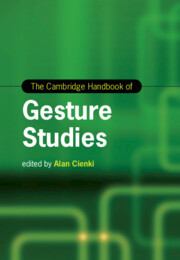Description
The Cambridge Handbook of Gesture Studies
Cambridge Handbooks in Language and Linguistics Series
Coordinator: Cienki Alan
Language: English
Subject for The Cambridge Handbook of Gesture Studies:
Publication date: 04-2024
710 p. · Hardback
710 p. · Hardback
Description
/li>Contents
/li>Biography
/li>
The study of gesture-the movements people make with their hands when talking-has grown into a well-established field and research is still being pushed into exciting new directions. Bringing together a team of leading scholars, this Handbook provides a comprehensive overview of gesture studies, combining historical overviews as well as current, concise snapshots of state-of-the-art, multidisciplinary research. Organised into five thematic parts, it considers the roles of both psychological and interactional processes in gesture use, and considers the status of gesture in relation to language. Attention is given to different theoretical and methodological frameworks for studying gesture, including semiotic, linguistic, cognitive, developmental, and phenomenological theories and observational, experimental, corpus linguistic, ethnographic, and computational methods. It also contains practical guidelines for gesture analysis along with surveys of empirical research. Wide ranging yet accessible, it is essential reading for academic researchers and students in linguistics and cognitive sciences.
Introduction Alan Cienki; Part I. Gestural Types: Forms and Functions: 1. Emblems Lluís Payrató; 2. Recurrent gestures: cultural, individual, and linguistic dimensions of meaning making Silva H. Ladewig; 3. Iconicity and representation in gesture Irene Mittelberg and Jennifer Hinnell; 4. Indexicality, deixis, and space in gesture Ellen Fricke; 5. From the neck up: facial gestures in dialogue Nicole Chovil; Part II. Ways of Approaching Gesture Analysis: 6. Contributions to the study of visible action as utterance: a fifty year retrospective Adam Kendon; 7. Systems of gesture coding and annotation Jana Bressem; 8. A toolbox of methods for gesture analysis Cornelia Müller; 9. The gestural sign: a concrete and reasoned analysis of co-speech gesture Geneviève Calbris and Mary M. Copple; 10. Creation and analysis of the multimedia Russian corpus for gesture research Ekaterina Rakhilina and Alan Cienki; 11. A kinesiological approach to gesture analysis Dominique Boutet and Alan Cienki; 12. Motion tracking technology for the study of gesture James Trujillo; Part III. Gestures and Language: 13. The role of gesture in debates on the origins of language Przemysław Żywiczyński and Jordan Zlatev; 14. Gesture and first language development: the multimodal child Aliyah Morgenstern; 15. Gesture and second/foreign language acquisition Marianne Gullberg; 16. Gesture and sign language Sherman Wilcox; 17. On grammar-gesture relations: gestures associated with negation Simon Harrison; Part IV. Gestures in Relation to Cognition: 18. The growth point David McNeill; 19. Gestures in cognition: actions that bridge the mind and the world Martha W. Alibali and Autumn B. Hostetter; 20. The neuroscience of gesture production Hedda Lausberg; 21. Gestures in learning and education Miriam A. Novack and Susan Goldin-Meadow; Part V. Gestures in Relation to Interaction: 22. Gesturing for the addressee Janet Bavelas; 23. Gesture and intersubjectivity Elena Clare Cuffari; 24. Variation in gesture: a sociocultural linguistic perspective Heather Brookes; 25. Communicative gesturing in interaction with robots Kristiina Jokinen; 26. Gestural interfaces in human-computer interaction Kashmiri Stec and Lars Bo Larsen.
Alan Cienki is Professor of Language Use & Cognition and English Linguistics at Vrije Universiteit, Amsterdam. He is the author of Ten Lectures on Spoken Language and Gesture (2017) and co-editor of Metaphor and Gesture (2008) and the two-volume handbook Body–Language–Communication (2013, 2014).
© 2024 LAVOISIER S.A.S.




